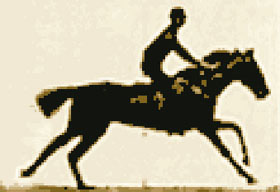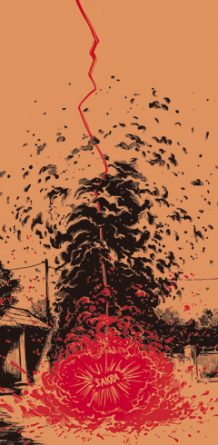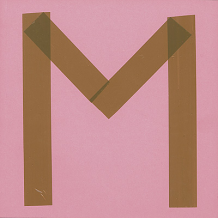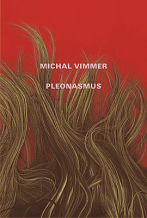| Umělec magazine 2001/3 >> Translated by Vladan Šír | List of all editions. | ||||||||||||
|
|||||||||||||
Translated by Vladan ŠírUmělec magazine 2001/301.03.2001 Miloš Vojtěchovský | film | en cs |
|||||||||||||
|
"“We have been ‘liberated’ in every sense of the term, so much so that we have moved beyond a certain spacetime, we’ve left
a certain horizon where the real was possible because gravitation was still strong enough for things to reflect on themselves and thereby possess or acquire some sort of duration (duree) and outcome.” Jean Baudrillard, Pataphysics of Year 2000 The simulation of an object in motion was first successfully captured by Eadweard Muy-bridge in California in 1872 when he took twelve photographs of the galloping horse Abe Edgington. He used twelve stereo cameras attached to electrical switches by twelve long threads stretched across the track in order to record the succession of images as the horse snapped through the threads, setting the cameras off one after another. The series was published in the book Animal Locomotion in 1887, featuring a selection of almost 20,000 images of people and animals “in motion.” With extremely precise descriptions, the book succeeds in demonstrating the mechanics of human and animal movement. Now, over one hundred years later, computer graphics exploit the imperfect optics of the human eye and the brain’s yen for perfection to charge images with the illusion of movement. With his optical gadgetry, Muybridge anticipated film, with its reels of preserved time; he showed how one “frame” instance connected to another. In fact, he designed the function of simulation, the “cinematic” animation of processes unfolding in time and space, a development of an archetype that can be found in art from the cave-paintings at Altamira to postmodernism. Although Muybridge considered himself a technician cooperating with a team of scientists rather than a visual artist, his take on the dark, flexuous universe gave the 20th century its leitmotif of visuality — made it the century of movement and film image. What is crucial about this New Image, an accidentally selected fragment of the infinite nebula of instances, or “forme unique nella continuita dello spazio,” as Umberto Boccini poetically called it, is that it has ceased to serve as a metaphorical reference to eternity, timelessness or even reality. The magic of represented movement being projected on celluloid or magnetic tape is now commonplace, and artists are looking at new ways to approach the image in time. Inspired by Muybridge’s mechanisms, the American visual artist Tim MacMillan inverts their traditional function. His digital film Ferment (1999) captured one moment in the life of the English town of Bath using a Josephine camera. The camera consists of 120 lenses recording separate spaces in a single moment. Viewers are “accidental” witnesses to the death of an old man on a park bench, the flight of a flock of pigeons disturbed by his fall to the ground, and the birth of a child a few blocks away. All of this is made present and scanned in one second. The film then unfolds in a panoramic space, following a horizontal timeline. The period of experiments at the end of the 19th century by such innovators as Muybridge, Marey, Eakins and the Lumiere brothers was preceded by a number of discoveries in natural sciences, psychology, and technology. Jan Evangelista Purkyně, for example, was a pioneer in the field of eye anatomy, investigating in particular vision and dizziness (Beitrage zur Kenntniss des Sehens in Subjektiver Hinsicht, 1819, 1823-1826). His mechanical proto-film machines — kinescopes — predicted concepts of thought and consciousness developed several decades later. They remain remarkably exciting and topical today, which is also true of Athanasius Kircher’s magical optical machines from the 17th century, which link the Baroque with today’s culture and its obsession with everything audiovisual. Now, at the beginning of the third millenium, we are surrounded by moving images that are different from those that people were used to 200 years ago. Electronic media have not only penetrated the social sphere of life, but have also started to crumble the borders of reality. Applied technoscience has multiplied the spheres of art, magic and economics into one indistinguishable complex. In addition to the linear, mechanical gaze from the lens of a film camera and the montage-mind of film editing (viewers facing the phantom of an approaching locomotive in a Lumiere brothers’ film had a hard time dealing with the experience a hundred years ago), we have also got used to hybrid models, introducing the motorized gaze, dynamic concepts of perspective, space, time and movement. These new “vistas” created through the optics of apparatuses reveal the way in which technology has implanted its dreamlike (hitherto) “unreal” parameters in the visual world. Armed with an optical machine, the prosthetically prolonged human gaze rushes like a bullet at a target; plunges to the beds of oceans, into the heart of matter; it explores microscopic organisms; it circles in the colorful hallucinogenic cycles of the ready-made imagination produced by software magicians; and it can look at the world through the eyes of fish, insects, predators, the prismatic eyes of a director and actor — can see as “the other.” By liberating vision from the eye’s, mind’s and body’s physical abilities, and by separating images from relations to their material substance — the physical medium — we create cinematic reality and into the realm of perception float these cinematic, phantom bodies. Subjective Objectivities Phylogenetically, the aimed and focused gaze is one of the basic tools animals have in their fight for survival and orientation in the world. It was the American philosopher and physicist David Bohm who noted that most of our conceptions of the physical world are determined by the fact that we perceive reality through a couple of lenses with changeable focus points — focusing, sharpening, and making up wholes. Sight is the most perfect tool we possess for discerning movement in space, locating food and indicating the level of remote danger. The ability to quickly focus the eye, estimate distance and turn the head 180 degrees did not make humans superior to their biological neighbors. But in combination with thinking, sight proved to be a miraculous weapon. Tools, perfected through a combination of reason, physical manipulation, and sight, contributed to our mastery of nature, while the expansion of the capacity of sight has helped us better control our remote surroundings. These tools are a wonderful instrument for “freezing” and destroying anything that is unfavorable in the immediate vicinity and for appropriating what is close to us. The eye’s gaze (where the view-finder and focus cross), indicator of the level of adrenaline in our blood, together with the magic of simulation of the naked “eye to eye” gaze, is one of the engines behind the development of audiovisual technology. Mathematical forms of images, which constitute their encoded essence, as opposed to their effectiveness, bear the qualities of a hologram. They are holistic, unlimited, invisible, going beyond common human experience outside the Euclidean-Newtonian world of phenomena “natural” for humans. Mathematical systems of data, monads, still resonate with thinking process through the monitor. Neurophysiologists describe the nervous system and memory as, among other things, spectral analyzers that store and distribute sensory signals in the brain in the form of holographic recordings. Global satellite systems are able to identify changes and movement across the surface of the planet. Our planet is a continuous multi-channel program of live broadcasting. Our applied digital evolution has opened the way for military optics to enter the secular world and has become the cause and advocate of its inconspicuous militarization. The “liberated” technical gaze of machines is becoming ever more apparent in everyday life: in television and film images, video games, video art, in various apparatuses used to shape the body, in the attractiveness of the media drift in advertising and politics, and in the stories that form their content. A powerful combination of aggression and sex appeal is manifest in the movement of mechanical optics along the vertical and horizontal axes, in the simulation of the speed of a bullet, the same speed at which the virtual camera moves in the cockpit of an imaginary space of a computer panorama, and in the delirious editing and merging of the montage imagination of corporeality. Just as we become mutants and cyborgs through mechanical images, the images transform into mutant images. Apparatuses — tools for the reproduction and generation of new data and images — feed on the fuel of information. They are their own justification, and have begun to play an increasingly important part in people’s social roles, psychology and psychopathology. And images, which in the original sense of the word once carried the gaze of their viewers, who co-created them and were their guarantors, now seem to be disappearing under the imperatives of post-industrial civilization. Gaze and Light in Film, Video and the Internet The rich iconography of the mediated “eye to eye” contact between the image and the viewer in the history of media and art suggests that it is one of the basic means of expression of the functioning imagery. Moreover, each mediated image of the human face, and especially of the gaze of the eyes, contains inherently the magical element of the viewer’s gaze which is also being captured. This effect is utilized deliberately not only in mass media (advertising and political strategy) but also in film and electronic art (including video art and net art). The continuous transformation of technical audiovisual means has profoundly influenced the way images are reproduced and — especially on the Internet — has come to define the very essence of their existence. Film and electronic media have placed the image back in its old environment — in the dark space of an interior, as in a cave or a cathedral. They have resurrected aspects of its nature long lost: it is again lunar, mysterious, intimate, ritual, obscene. The museum and gallery mostly surround images with external, natural light. Or artificial light that imitates daylight. Laterna magica, camera obscura, film, television, video art and computers have all brought twilight back to the human dialogue with images, destabilizing the uncertain boundary between the image and the environment, encouraging contemplation and an archaic fascination with movement as they shed their diffusive light in the dark. Renaissance, modernism, positivism and the corresponding dialogue with classical painting and artifact all offered the viewer distance, and a control over the light that was a part of their external space. To what extent is electrically radiated light a real part of film, video or the information on the monitor? An artist using such tools reigns over the mental state of the viewer through the creation of particular atmospheres of light, despite the fact that the medium via which the images are being projected — electricity — is beyond the viewer’s reach. With electric power, technical civilization has created global interconnectivity, but the links it forges are intangible, whether they exist as film projection, TV broadcasting or real-time communication over the net. The creator of luminous images exercises the same power over the viewer’s time, though the viewer can break the relationship by stopping the projection of the film or video. In the case of video games and interactive 3D installations, the domination over the viewer is extended to his motor abilities and his perception of reality. A Place, a Copy, a Hyper-image Our relationship to the private and the public, to space and place, changes under the influence of the images, texts and sounds emitted continuously by our monitors, which are created somewhere on the Internet, out of our physical reach and out of our time zone. Boris Groys considers “spiritist experience” the closest metaphor for communication over the Internet. A person who wants to enter a communication seance must use some kind of password, code, formula, or symbol. Light particles organize themselves, either immediately or gradually, into some kind of shape on the projection device, a shape that may or may not be understood, and one with which it may or may not possible to communicate. The shape can also be sent off into the electronic void with a single twitch of the hand. From a certain point of view, a total network is nothing but applied spiritism, and the language is becoming an ever deeper layer, submerged by images and sounds. Language is no longer primarily a mathematical description as it used to be in the old days of the Internet; it is more of an oracle, an invoker of images and sounds; it is a nebula of gazes traveling from here to there, from somewhere to somewhere else. Although it was itself created as a function of some external pattern, the net turns each situation and bit of information into a shadow of the original. Registered and stored in some kind of topological system, data are transmitted into the terminal that requested the address but are not saved in an archive. Original data are stored as a folder in a real computer with a real person sitting at its keyboard; it is part of that particular extant hardware in which it is inscribed. By inserting the gem, by entering the correct formula, contact is made: a sterile variation on the eye-to-eye and face-to-face gaze of the pre-monitor era of communication, and the interlocutor is outside the physical vicinity. By changing the code, switching the keys, a new phantom is made to emerge, which can be experienced in Gary Hill’s installation Tall Ships: A movement sensor revives one of the figures, who gives a monologue to people passing through the long dark corridor, which symbolizes the path into a crypt, into oblivion. To what extent can the myriad digital images of people, faces, bodies and photographs of events from “the other side of the world,” from the past, thousands of historical documents, be connected into some holographic entity? Perhaps it is true that an organic, pulsating hyperimage is being created outside our individual consciousnesses, to which more and more binary encoded units are endlessly added. In which case, would one strong electromagnetic discharge be enough to send us back to pre-image ground zero, to return us to a point without the dominating holistic gaze where the naked look into the eye of a stranger or the depth of a blue sky reigns supreme? Are we still in the picture? If these flowing images make up a database of the collective consciousness of humankind, the question arises as to where this flow will end. Technology introduces a lack of engagement into our lives: Experienced in the context of Western civilization, it can look like a highway straight to entropy. How did Eadweard Muybridge succeed in persuading his models to allow the motionless, cold eye of the camera to dissect their absurdly beautiful movements? Are our dangerous liaisons with the dizzy flow of images a flash of planetary introspection, or have we broken the mirror of cyclical time and stranded ourselves in a desert of loneliness and impotence? “If the 20th century taught us anything, it is the realization of the fact that there are so many forms and cultures in the world that it is impossible to embrace them all in one image, one thought, one word,” wrote Paul D. Millar, a.k.a. DJ Spooky That Subliminal Kid, in a text from Santiago de Chile. Did he mean to imply that the technological ability to sample, mix and cross sounds, images and words into one performance contains the promise of redemption? That wholeness can be derived from fragmentation? Perhaps this hope is the old formula that we use to hold anxiety at bay, threatened by the frightening maelstrom of imagery we’ve been spinning in since the moment Muybridge placed his cameras along the side of a racetrack. "
01.03.2001
Recommended articles
|
|||||||||||||
|
04.02.2020 10:17
Letošní 50. ročník Art Basel přilákal celkem 93 000 návštěvníků a sběratelů z 80 zemí světa. 290 prémiových galerií představilo umělecká díla od počátku 20. století až po současnost. Hlavní sektor přehlídky, tradičně v prvním patře výstavního prostoru, představil 232 předních galerií z celého světa nabízející umění nejvyšší kvality. Veletrh ukázal vzestupný trend prodeje prostřednictvím galerií jak soukromým sbírkám, tak i institucím. Kromě hlavního veletrhu stály za návštěvu i ty přidružené: Volta, Liste a Photo Basel, k tomu doprovodné programy a výstavy v místních institucích, které kvalitou daleko přesahují hranice města tj. Kunsthalle Basel, Kunstmuseum, Tinguely muzeum nebo Fondation Beyeler.
|



































 New book by I.M.Jirous in English at our online bookshop.
New book by I.M.Jirous in English at our online bookshop.
Comments
There are currently no comments.Add new comment